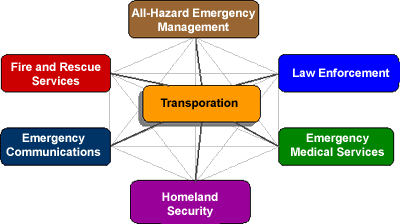 Transportation and emergency service agencies work together on a frequent basis to handle a wide range of events that impact the transportation system, threaten public health and safety, and have other economic, environmental and social consequences. The events that bring these agencies together include all of the following: 1) Minor traffic incidents, including disabled or abandoned vehicles, crashes, debris, and other obstructions; 2) Construction and maintenance work zones (temporary and long-term); 3) Major traffic crashes involving fatalities, injuries, overturned vehicles, and serious property damage, 4) Hazardous material spills; 5) Severe weather and natural disasters, including events that require large-scale evacuation; 6) Public health emergencies; 7) Acts of terrorism that target the transportation infrastructure or transportation users or that create exceptional demands on the transportation system
Transportation and emergency service agencies work together on a frequent basis to handle a wide range of events that impact the transportation system, threaten public health and safety, and have other economic, environmental and social consequences. The events that bring these agencies together include all of the following: 1) Minor traffic incidents, including disabled or abandoned vehicles, crashes, debris, and other obstructions; 2) Construction and maintenance work zones (temporary and long-term); 3) Major traffic crashes involving fatalities, injuries, overturned vehicles, and serious property damage, 4) Hazardous material spills; 5) Severe weather and natural disasters, including events that require large-scale evacuation; 6) Public health emergencies; 7) Acts of terrorism that target the transportation infrastructure or transportation users or that create exceptional demands on the transportation system
In most communities, transportation and emergency services organizations would categorize their working relationships as "good" and would refer to effective levels of "coordination and cooperation" as required by the circumstances. However, closer examination would reveal that the organizations responsible for transportation and those responsible for emergency services have little shared knowledge or mutual understanding of capabilities or constraints. As transportation and emergency services decision-making processes are largely independent, opportunities for complementary or mutually beneficial advances may not even be recognized.
From a risk management perspective, the relationships between transportation and emergency service agencies need to move beyond "cooperation and coordination" towards achieving a comprehensive level of "integration." More effective incident management is needed to deal with the relatively minor traffic incidents that occur on a daily basis and create significant congestion, cause wasted time and fuel, and endanger other motorists as well as the incident responders. At the other end of the risk management continuum, effective homeland security demands that the same agencies be prepared for the less likely but more catastrophic events. In between, work zone planning and management, response to severe weather events, and handling of hazardous spills have significant economic, safety, and security implications.
The proposed research would systematically address the integration of transportation and emergency services to accomplish four interrelated purposes:
- Describe the state of the practice
- Identify and diagram critical interface activities and decision-making processes
- Assess interface vulnerabilities and opportunities for improvement
- Make recommendations that address the most important vulnerabilities and opportunities through specific tactical and strategic initiatives.